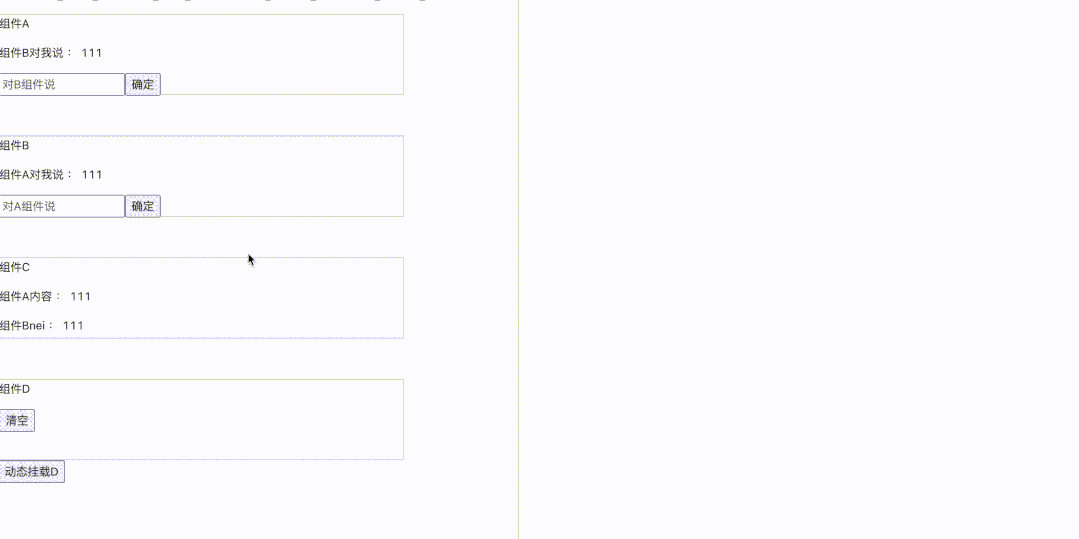「React进阶」只用两个自定义 Hooks 就能替代 React-Redux ?
共 17636字,需浏览 36分钟
·
2021-07-30 00:39
前言
之前有朋友问我,React Hooks 能否解决 React 项目状态管理的问题。这个问题让我思索了很久,最后得出的结论是:能,不过需要两个自定义 hooks 去实现。那么具体如何实现的呢?那就是今天要讲的内容了。
通过本文,你能够学习以下内容:
useContext ,useRef ,useMemo,useEffect 的基本用法。 如何将不同组件的自定义 hooks 建立通信,共享状态。 合理编写自定义 hooks , 分析 hooks 之间的依赖关系。 自定义 hooks 编写过程中一些细节问题。
带着如上的知识点,开启阅读之旅吧~
一 设计思路
首先,看一下要实现的两个自定义 hooks 具体功能。
useCreateStore用于产生一个状态 Store ,通过 context 上下文传递 ,为了让每一个自定义 hooksuseConnect都能获取 context 里面的状态属性。useConnect使用这个自定义 hooks 的组件,可以获取改变状态的 dispatch 方法,还可以订阅 state ,被订阅的 state 发生变化,组件更新。
如何让不同组件的自定义 hooks 共享状态并实现通信呢?
首先不同组件的自定义 hooks ,可以通过 useContext 获得共有状态,而且还需要实现状态管理和组件通信,那么就需要一个状态调度中心来统一做这些事,可以称之为 ReduxHooksStore ,它具体做的事情如下:
全局管理 state, state 变化,通知对应组件更新。 收集使用 useConnect组件的信息。组件销毁还要清除这些信息。维护并传递负责更新的 dispatch方法。一些重要 api 要暴露给 context 上下文,传递给每一个 useConnect。
1 useCreateStore 设计
首先 useCreateStore 是在靠近根部组件的位置的, 而且全局只需要一个,目的就是创建一个 Store ,并通过 Provider 传递下去。
使用:
const store = useCreateStore( reducer , initState )
参数:
reducer:全局 reducer,纯函数,传入 state 和 action ,返回新的 state 。initState:初始化 state 。
返回值:为 store 暴露的主要功能函数。
2 Store设计
Store 为上述所说的调度中心,接收全局 reducer ,内部维护状态 state ,负责通知更新 ,收集用 useConnect 的组件。
const Store = new ReduxHooksStore(reducer,initState).exportStore()
参数:接收两个参数,透传 useCreateStore 的参数。
3 useConnect设计
使用 useConnect 的组件,将获得 dispatch 函数,用于更新 state ,还可以通过第一个参数订阅 state ,被订阅的 state 改变 ,会让组件更新。
// 订阅 state 中的 number
const mapStoreToState = (state)=>({ number: state.number })
const [ state , dispatch ] = useConnect(mapStoreToState)
参数:
mapStoreToState:将 Store 中 state ,映射到组件的 state 中,可以做视图渲染使用。如果没有第一个参数,那么只提供 dispatch函数,不会订阅 state 变化带来的更新。
返回值:返回值是一个数组。
数组第一项:为映射的 state 的值。 数组第二项:为改变 state 的 dispatch函数。
4 原理图

二 useCreateStore
export const ReduxContext = React.createContext(null)
/* 用于产生 reduxHooks 的 store */
export function useCreateStore(reducer,initState){
const store = React.useRef(null)
/* 如果存在——不需要重新实例化 Store */
if(!store.current){
store.current = new ReduxHooksStore(reducer,initState).exportStore()
}
return store.current
}
useCreateStore 主要做的是:
接收
reducer和initState,通过 ReduxHooksStore 产生一个 store ,不期望把 store 全部暴露给使用者,只需要暴露核心的方法,所以调用实例下的exportStore抽离出核心方法。使用一个
useRef保存核心方法,传递给Provider。
三 状态管理者 —— ReduxHooksStore
接下来看一下核心状态 ReduxHooksStore 。
import { unstable_batchedUpdates } from 'react-dom'
class ReduxHooksStore {
constructor(reducer,initState){
this.name = '__ReduxHooksStore__'
this.id = 0
this.reducer = reducer
this.state = initState
this.mapConnects = {}
}
/* 需要对外传递的接口 */
exportStore=()=>{
return {
dispatch:this.dispatch.bind(this),
subscribe:this.subscribe.bind(this),
unSubscribe:this.unSubscribe.bind(this),
getInitState:this.getInitState.bind(this)
}
}
/* 获取初始化 state */
getInitState=(mapStoreToState)=>{
return mapStoreToState(this.state)
}
/* 更新需要更新的组件 */
publicRender=()=>{
unstable_batchedUpdates(()=>{ /* 批量更新 */
Object.keys(this.mapConnects).forEach(name=>{
const { update } = this.mapConnects[name]
update(this.state)
})
})
}
/* 更新 state */
dispatch=(action)=>{
this.state = this.reducer(this.state,action)
// 批量更新
this.publicRender()
}
/* 注册每个 connect */
subscribe=(connectCurrent)=>{
const connectName = this.name + (++this.id)
this.mapConnects[connectName] = connectCurrent
return connectName
}
/* 解除绑定 */
unSubscribe=(connectName)=>{
delete this.mapConnects[connectName]
}
}
状态
reducer:这个 reducer 为全局的 reducer ,由 useCreateStore 传入。state:全局保存的状态 state ,每次执行 reducer 会得到新的 state 。mapConnects:里面保存每一个 useConnect 组件的更新函数。用于派发 state 改变带来的更新。
方法
负责初始化:
getInitState:这个方法给自定义 hooks 的 useConnect 使用,用于获取初始化的 state 。exportStore:这个方法用于把 ReduxHooksStore 提供的核心方法传递给每一个 useConnect 。
负责绑定|解绑:
subscribe:绑定每一个自定义 hooks useConnect 。unSubscribe:解除绑定每一个 hooks 。
负责更新:
dispatch:这个方法提供给业务组件层,每一个使用 useConnect 的组件可以通过 dispatch 方法改变 state ,内部原理是通过调用 reducer 产生一个新的 state 。publicRender:当 state 改变需要通知每一个使用 useConnect 的组件,这个方法就是通知更新,至于组件需不需要更新,那是 useConnect 内部需要处理的事情,这里还有一个细节,就是考虑到 dispatch 的触发场景可以是异步状态下,所以用 React-DOM 中 unstable_batchedUpdates 开启批量更新原则。
四 useConnect
useConnect 是整个功能的核心部分,它要做的事情是获取最新的 state ,然后通过订阅函数 mapStoreToState 得到订阅的 state ,判断订阅的 state 是否发生变化。如果发生变化渲染最新的 state 。
export function useConnect(mapStoreToState=()=>{}){
/* 获取 Store 内部的重要函数 */
const contextValue = React.useContext(ReduxContext)
const { getInitState , subscribe ,unSubscribe , dispatch } = contextValue
/* 用于传递给业务组件的 state */
const stateValue = React.useRef(getInitState(mapStoreToState))
/* 渲染函数 */
const [ , forceUpdate ] = React.useState()
/* 产生 */
const connectValue = React.useMemo(()=>{
const state = {
/* 用于比较一次 dispatch 中,新的 state 和 之前的state 是否发生变化 */
cacheState: stateValue.current,
/* 更新函数 */
update:function (newState) {
/* 获取订阅的 state */
const selectState = mapStoreToState(newState)
/* 浅比较 state 是否发生变化,如果发生变化, */
const isEqual = shallowEqual(state.cacheState,selectState)
state.cacheState = selectState
stateValue.current = selectState
if(!isEqual){
/* 更新 */
forceUpdate({})
}
}
}
return state
},[ contextValue ]) // 将 contextValue 作为依赖项。
React.useEffect(()=>{
/* 组件挂载——注册 connect */
const name = subscribe(connectValue)
return function (){
/* 组件卸载 —— 解绑 connect */
unSubscribe(name)
}
},[ connectValue ]) /* 将 connectValue 作为 useEffect 的依赖项 */
return [ stateValue.current , dispatch ]
}
初始化
用 useContext 获取上下文中, ReduxHooksStore 提供的核心函数。 用 useRef 来保存得到的最新的 state 。 用 useState 产生一个更新函数 forceUpdate,这个函数只是更新组件。
注册|解绑流程
注册:通过
useEffect来向 ReduxHooksStore 中注册当前 useConnect 产生的 connectValue ,connectValue 是什么马上会讲到。subscribe 用于注册,会返回当前 connectValue 的唯一标识 name 。解绑:在 useEffect 的销毁函数中,可以用调用 unSubscribe 传入 name 来解绑当前的 connectValue
connectValue是否更新组件
connectValue :真正地向 ReduxHooksStore 注册的状态,首先用
useMemo来对 connectValue 做缓存,connectValue 为一个对象,里面的 cacheState 保留了上一次的 mapStoreToState 产生的 state ,还有一个负责更新的 update 函数。更新流程 :当触发
dispatch在 ReduxHooksStore 中,会让每一个 connectValue 的 update 都执行, update 会触发映射函数mapStoreToState来得到当前组件想要的 state 内容。然后通过shallowEqual浅比较新老 state 是否发生变化,如果发生变化,那么更新组件。完成整个流程。shallowEqual :这个浅比较就是 React 里面的浅比较,在第 11 章已经讲了其流程,这里就不讲了。
分清依赖关系
首先自定义 hooks useConnect 的依赖关系是上下文 contextValue 改变,那么说明 store 发生变化,所以重新通过 useMemo 产生新的 connectValue 。所以 useMemo 依赖 contextValue。
connectValue 改变,那么需要解除原来的绑定关系,重新绑定。useEffect 依赖 connectValue。
局限性
整个 useConnect 有一些局限性,比如:
没有考虑 mapStoreToState 可变性,无法动态传入 mapStoreToState 。 浅比较,不能深层次比较引用数据类型。
五 使用与验证效果
接下来就是验证效果环节,我模拟了组件通信的场景。
根部组件注入 Store
import { ReduxContext , useConnect , useCreateStore } from './hooks/useRedux'
function Index(){
const [ isShow , setShow ] = React.useState(true)
console.log('index 渲染')
return <div>
<CompA />
<CompB />
<CompC />
{isShow && <CompD />}
<button onClick={() => setShow(!isShow)} >点击</button>
</div>
}
function Root(){
const store = useCreateStore(function(state,action){
const { type , payload } =action
if(type === 'setA' ){
return {
...state,
mesA:payload
}
}else if(type === 'setB'){
return {
...state,
mesB:payload
}
}else if(type === 'clear'){ //清空
return { mesA:'',mesB:'' }
}
else{
return state
}
},
{ mesA:'111',mesB:'111' })
return <div>
<ReduxContext.Provider value={store} >
<Index/>
</ReduxContext.Provider>
</div>
}
Root根组件
通过 useCreateStore 创建一个 store ,传入 reducer 和 初始化的值 { mesA:'111',mesB:'111' }用 Provider 传递 store。
Index组件
有四个子组件 CompA , CompB ,CompC ,CompD 。其中 CompD 是 动态挂载的。
业务组件使用
function CompA(){
const [ value ,setValue ] = useState('')
const [state ,dispatch ] = useConnect((state)=> ({ mesB : state.mesB }) )
return <div className="component_box" >
<p> 组件A</p>
<p>组件B对我说 : {state.mesB} </p>
<input onChange={(e)=>setValue(e.target.value)}
placeholder="对B组件说"
/>
<button onClick={()=> dispatch({ type:'setA' ,payload:value })} >确定</button>
</div>
}
function CompB(){
const [ value ,setValue ] = useState('')
const [state ,dispatch ] = useConnect((state)=> ({ mesA : state.mesA }) )
return <div className="component_box" >
<p> 组件B</p>
<p>组件A对我说 : {state.mesA} </p>
<input onChange={(e)=>setValue(e.target.value)}
placeholder="对A组件说"
/>
<button onClick={()=> dispatch({ type:'setB' ,payload:value })} >确定</button>
</div>
}
function CompC(){
const [state ] = useConnect((state)=> ({ mes1 : state.mesA,mes2 : state.mesB }) )
return <div className="component_box" >
<p>组件A : {state.mes1} </p>
<p>组件B : {state.mes2} </p>
</div>
}
function CompD(){
const [ ,dispatch ] = useConnect( )
console.log('D 组件更新')
return <div className="component_box" >
<button onClick={()=> dispatch({ type:'clear' })} > 清空 </button>
</div>
}
CompA 和 CompB 模拟组件双向通信。 CompC 组件接收 CompA 和 CompB 通信内容,并映射到 mes1 ,mes2属性上。CompD 没有 mapStoreToState ,没有订阅 state ,state 变化组件不会更新,只是用 dispatch 清空状态。
效果

六 总结
本文通过两个自定义 hooks 实现了 React-Redux 的基本功能,这个模式在真实项目中可以使用吗?我觉得如果是小型项目,是完全可以使用的,对于大型项目还是用 React Redux 或者其他成熟的状态管理工具。
以上便是本次分享的全部内容,希望对你有所帮助^_^
喜欢的话别忘了 分享、点赞、收藏 三连哦~。
欢迎关注公众号 前端Sharing 持续分享高质量文章~
